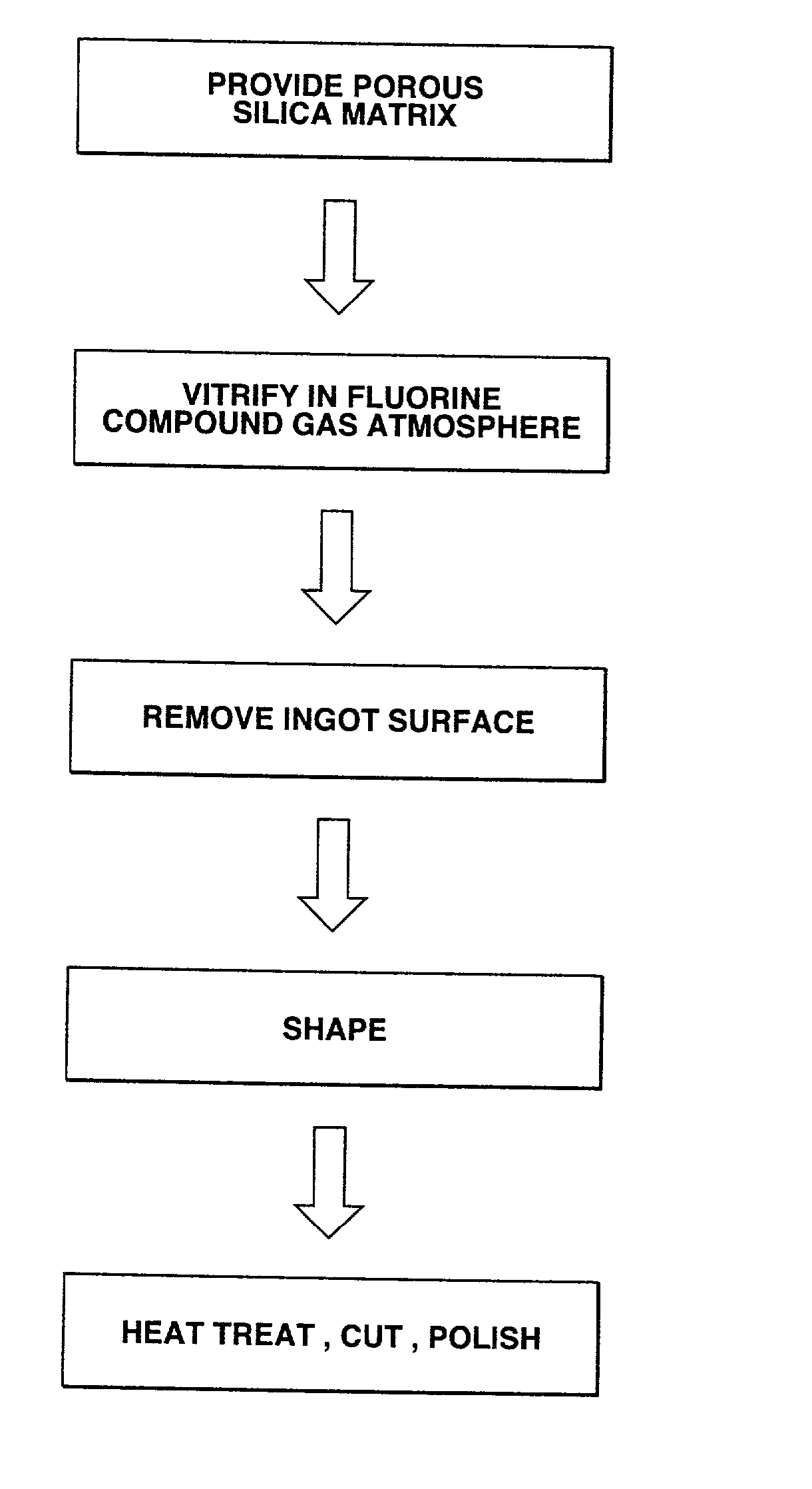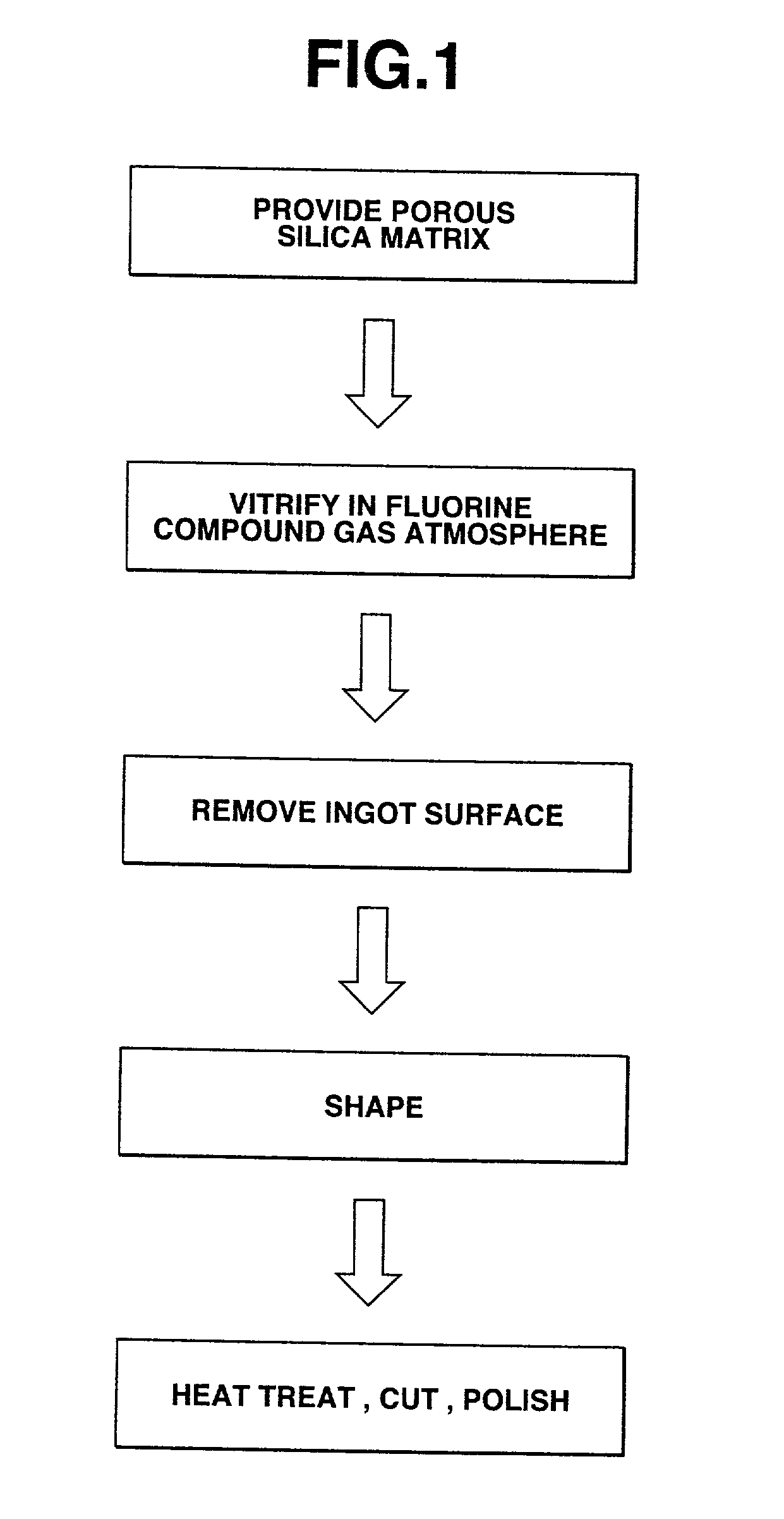Synthetic quartz glass article and process of production
a technology of synthetic quartz glass and glass articles, applied in glass making apparatus, manufacturing tools, instruments, etc., can solve the problems of material strength, surface polishing, coefficient of thermal expansion, etc., and achieve the effects of low birefringence, small refractive index, and high transmittan
- Summary
- Abstract
- Description
- Claims
- Application Information
AI Technical Summary
Benefits of technology
Problems solved by technology
Method used
Image
Examples
example 1
[0045] A porous silica matrix was produced by feeding from a burner hydrogen gas, oxygen gas, and tetramethoxysilane gas as the silica-forming reactant, and carrying out hydrolysis in an oxyhydrogen flame. The matrix was heated to 1,500.degree. C. in an atmosphere of SiF.sub.4 and He mixture, forming a cylindrical synthetic quartz glass ingot.
[0046] The outer periphery of the ingot was removed by cylindrical grinding in an amount of 25% of the outer diameter, and the opposite ends of the ingot were removed each in an amount of 10% of the longitudinal length, and 20% in total. The ingot whose peripheral and end portions had been removed was shaped in an electric furnace, finally obtaining a substrate of 152.4 mm square and 6.35 mm thick.
[0047] The substrate had a transmittance as measured at 157.6 nm of 84.0 to 84.5% within the substrate plane. The transmittance measured at 193.4 nm was 90.60 to 90.75% within the substrate plane. The birefringence was 3 nm / cm. The refractive index di...
example 2
[0048] A porous silica matrix was produced by feeding from a burner hydrogen gas, oxygen gas, and tetramethoxysilane gas as the silica-forming reactant, and carrying out hydrolysis in an oxyhydrogen flame. The matrix was heated to 1,500.degree. C. in an atmosphere of SiF.sub.4 and He mixture, forming a cylindrical synthetic quartz glass ingot.
[0049] The outer periphery of the ingot was removed by cylindrical grinding in an amount of 5% of the outer diameter, and the opposite ends of the ingot were removed each in an amount of 2.5% of the longitudinal length, and 5% in total. The ingot whose peripheral and end portions had been removed was shaped in an electric furnace, finally obtaining a substrate of 152.4 mm square and 6.35 mm thick.
[0050] The substrate had a transmittance as measured at 157.6 nm of 83.5 to 84.5% within the substrate plane. The transmittance measured at 193.4 nm was 90.50 to 90.70% within the substrate plane. The birefringence was 10 nm / cm. The refractive index di...
example 3
[0051] A porous fluorine-containing silica matrix was produced by feeding from a burner hydrogen gas, oxygen gas, tetramethoxysilane gas as the silica-forming reactant, and SiF.sub.4 gas, and carrying out hydrolysis in an oxyhydrogen flame. The matrix was heated to 1,500.degree. C. in an atmosphere of SiF.sub.4 and He mixture, forming a cylindrical synthetic quartz glass ingot.
[0052] The outer periphery of the ingot was removed by cylindrical grinding in an amount of 10% of the outer diameter, and the opposite ends of the ingot were removed each in an amount of 5% of the longitudinal length, and 10% in total. The ingot whose peripheral and end portions had been removed was shaped in an electric furnace, finally obtaining a substrate of 152.4 mm square and 6.35 mm thick.
[0053] The substrate had a transmittance as measured at 157.6 nm of 84.2 to 84.9% within the substrate plane. The transmittance measured at 193.4 nm was 90.55 to 90.75% within the substrate plane. The birefringence wa...
PUM
| Property | Measurement | Unit |
|---|---|---|
| Fraction | aaaaa | aaaaa |
| Fraction | aaaaa | aaaaa |
| Dimensionless property | aaaaa | aaaaa |
Abstract
Description
Claims
Application Information
 Login to View More
Login to View More - R&D
- Intellectual Property
- Life Sciences
- Materials
- Tech Scout
- Unparalleled Data Quality
- Higher Quality Content
- 60% Fewer Hallucinations
Browse by: Latest US Patents, China's latest patents, Technical Efficacy Thesaurus, Application Domain, Technology Topic, Popular Technical Reports.
© 2025 PatSnap. All rights reserved.Legal|Privacy policy|Modern Slavery Act Transparency Statement|Sitemap|About US| Contact US: help@patsnap.com


